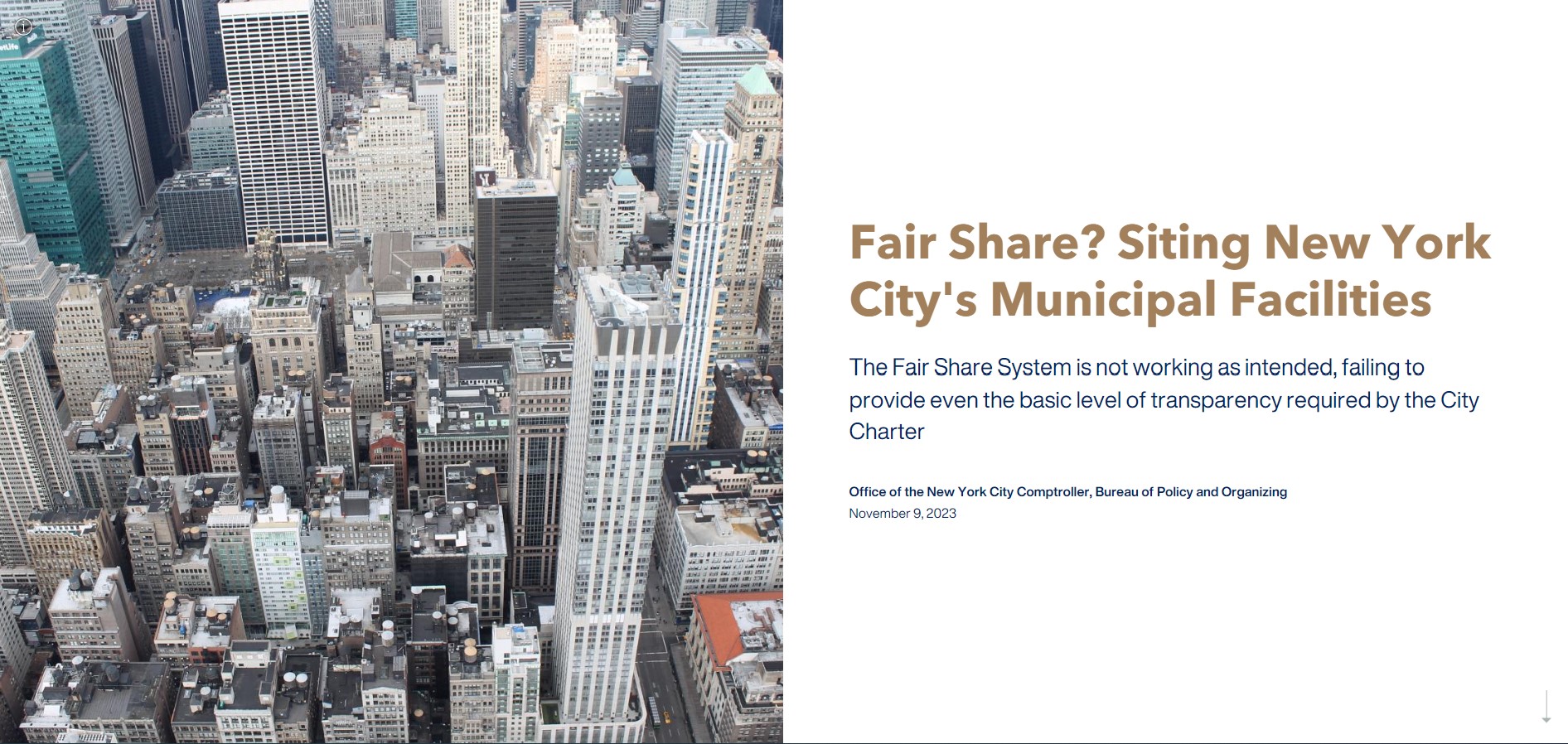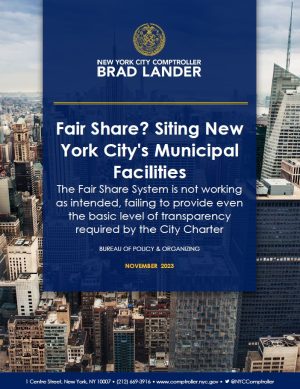Fair Share? Siting New York City’s Municipal Facilities
Executive Summary
The wellbeing of a city of more than eight million people rests upon an extensive array of municipal infrastructure and services. Fire stations, police precincts, and EMS bases to respond to emergencies. Sanitation garages and waste transfer stations to dispose of our trash. Libraries to provide access to knowledge and strengthen community connections. Parks, pools, plazas, and green spaces for essential recreation. Nursing homes and childcare centers to support families. Homeless shelters, substance abuse treatment centers, and mental health clinics to provide people in crisis with shelter and care.
In some cases, New Yorkers are grateful for new infrastructure in their communities – neighbors and local elected officials work together to fight for investments in new plazas, parks, and libraries. In other cases, people would rather not have City services and infrastructure sited right on their block. Some City facilities – like waste transfer stations – are claimed by some to be toxic and harmful to health. Others – like homeless shelters and substance use disorder treatment centers – are seen by many as a drag on quality of life, the local economy and property values.
So the City is presented with the messy and complicated challenge of deciding where and how to site municipal infrastructure and services in the face of practical constraints (e.g. limited agency budgets, zoning regulations, and finite space) and, in many cases, community opposition. Too often, those constraints reinforce inequality in our City – whiter, wealthier neighborhoods are less likely to see heavy concentrations of “unwelcomed” facilities like shelters and waste transfer stations, and more likely to be well-served by “welcomed” amenities like parks and green spaces.
Recognizing the City’s disproportionate siting of “undesirable” facilities in low-income communities of color, the 1989 New York City Charter Revision Commission proposed a process to confront this challenge. “Fair Share” created a structured framework for siting City facilities in pursuit of distributional fairness. The City’s Fair Share process is grounded in principles of both fairness and solidarity – it suggests that every community has both a right to a fair share of services (“getting its fair share”) and a social and moral obligation to help meet our City’s collective needs (“doing its fair share”).
Adopted in the 1989 Charter Revision, Fair Share required the City to make a concerted effort to ensure that communities are both getting their fair share of amenities like parks and libraries and doing their fair share to confront and help solve citywide problems like homelessness. To address the real-life challenges that agencies face in siting critical infrastructure, the Charter Revision Commission designed Fair Share to focus on public process and transparency. There are no rigid standards for what “fairness” means exactly, but rather a series of analyses and disclosures that agencies are required to produce when they site or expand a long list of municipal facilities and services. The Charter Revision Commission hoped that by bringing sunlight to where and how those facilities are sited, communities and decision makers would be armed with the data and information they need to distribute them more fairly over time.
Unfortunately, more than thirty years later, Fair Share has failed even at the first step of bringing the public transparency envisioned by the Charter Revision Commission to the City’s facility siting process.
Key Findings
Fair Share Process
An audit by the Comptroller’s Office reveals that:
- Critical data on the capacity and concentration of existing City facilities are unavailable to the public and agency decision makers.
- When siting new facilities, the City often fails to produce its mandated analyses of neighborhood impact altogether.
- The Bed to Population (BTP) ratio has not been updated in nearly a decade, and requirements to refrain from siting residential facilities in areas with a high BTP have been wholly ignored.
In the absence of even the basic level of transparency and disclosure required by the Charter’s Fair Share rules, it is not possible to fully assess the broader goal of distributional fairness that the 1989 Charter Revision Commission hoped the new rules would help achieve. To better understand how the City’s failure to implement Fair Share is impacting the City’s neighborhoods, the Comptroller’s Office used the best available data to perform a geographic analysis of certain City facilities. The analysis covered childcare and early childhood education centers, fire stations, parks, police stations, homeless shelters (including sanctuary sites and Humanitarian Emergency Response and Relief Centers, or HERRCs), social services (including mental health services and substance use disorder treatment centers), and waste transfer sites. [1]
Analysis of City Facility Concentration
The Comptroller’s Office geospatial analysis finds that:
- Three facility types – childcare and early childhood education facilities, fire stations, and police precincts – are generally distributed fairly.
- Four facility types – parks, waste transfer sites, homeless shelters (including sanctuary sites and HERRCs), and social services (including mental health centers and substance use disorder treatment programs) – are distributed unfairly.
When facilities are sited unfairly, the burdens and the benefits of those City facilities are unevenly distributed, exacerbating racial and economic disparities:
- Homeless shelters are heavily concentrated, with some communities taking on 100 times more shelter beds than others, and four community districts having no shelters at all. Overall, the demographic of neighborhoods with no shelter beds are predominately white.
- Waste transfer sites, which bring along with them truck traffic, noise, greenhouse gas emissions, and particulate matter are more likely to be sited in communities with a higher percentage of people living below the poverty line.
- Neighborhoods with significant populations of people with Asian heritage are underserved by parks, which are essential infrastructure for New Yorkers’ physical, mental, and social health, and protect vulnerable New Yorkers from the impacts of extreme heat.
- Social services, including mental health service centers and substance use disorder treatment programs, which provide critical care to some of the city’s most vulnerable populations, are much more likely to be sited in neighborhoods with a higher percentage of people living below the poverty line. [2]
These findings are especially relevant at this moment, as New York City welcomes upwards of 100,000 asylum seekers and the housing affordability crisis continues to worsen, putting the Adams Administration under enormous pressure to site a record number of new homeless shelters and sanctuary sites. Siting these new City facilities is critical to meeting the City’s Right to Shelter obligation, which will keep new arrivals and New Yorkers from being forced to sleep on the streets and prevent further strain on neighborhoods and City services. However, in the absence of Fair Share, there are no guardrails in place to ensure that all neighborhoods are doing their part to step up and respond to this crisis or that neighborhoods with high concentrations of newcomers have the necessary support services (e.g. job training centers) and infrastructure (e.g. school seats) they need to serve those populations. Facilities sited through emergency procurement today may create and deepen disparities across our neighborhoods for years to come.
Recommendations
The Comptroller’s audit found that Fair Share is badly broken: the City is failing to meet its Charter obligations which were designed to bring more data and transparency to how the City sites facilities in pursuit of more equitable outcomes. The additional geographic analysis provided here offers a sense of how the City is measuring up against goals of fairness. It is little surprise that, in the absence of a functioning Fair Share system, “welcomed” and “unwelcomed” facilities alike are often distributed unfairly, exacerbating racial and economic disparities in our city.
To produce more equitable outcomes, the City should reform its Fair Share policies and procedures to:
- Establish Clear, Centralized City Oversight over Fair Share Compliance
- Improve and Regularly Update the Fair Share Criteria
- Improve Public Access to Information on Sitings, Facility Capacity and Concentration
- Reform the Citywide Statement of Needs
- Prohibit Unfair Sitings in Over-Saturated Districts
- Clarify that Fair Share should be applied to City Facilities Sited through Emergency Procurement

